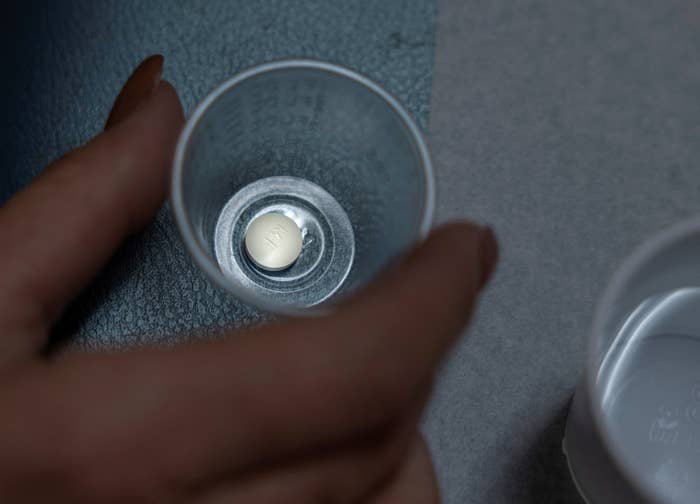
A drug approved by the FDA over two decades ago for use in medical abortions and miscarriages is at risk of being pulled from the market after a decision by a Trump-appointed federal judge in Texas on Friday.
However, a second federal judge in Washington state issued a competing ruling that would prohibit the FDA from pulling the drug, mifepristone, off the market, in the 12 states covered by the ruling, which include Washington, Oregon, Arizona, Colorado, New Mexico, and Vermont.
The conflicting rulings may set the stage for a Supreme Court battle over the drug, which is used in combination with misoprostol for medical abortions and to treat miscarriages.
In the Texas ruling, US District Judge Matthew Kacsmaryk said the FDA did not consider "the psychological effects of the drug or an evaluation of the longterm medical consequences of the drug.” His decision is on hold for seven days, giving the Biden administration time to appeal — which it has already done. On Friday night, the Department of Justice filed an appeal in the Texas case, and issued a statement saying it "strongly disagrees" with the ruling. The DOJ will also review the Washington ruling.
As of April 8, mifepristone is still available in the United States. Depending on the ultimate decision, it could mean that mifepristone, which is widely considered safe by medical experts, may not be able to be dispensed even in states where abortion is legal.
The medical community is in consensus that mifepristone, which was first approved in 2000, is safe under its current regulations. The American College of Obstetricians and Gynecologists, American Medical Association, Society for Maternal-Fetal Medicine, and nine other medical organizations submitted a brief to the US District Court for the Northern District of Texas, Amarillo Division, saying there is “overwhelming evidence demonstrating that mifepristone — which has undergone rigorous testing and review and has been safely used in the United States for 23 years — is conclusively safe and effective.”
Coming on the heels of last year’s overturn of Roe v. Wade, the Texas ruling, which major medical groups said is not based on science, would place further burdens on equal access to reproductive healthcare, including abortion treatment. A Christian legal group filed the lawsuit claiming, among other things, that mifepristone is a dangerous drug and the FDA has “failed America’s women and girls.”
The lawsuit is the latest step in a long-running effort to restrict or even ban abortion across the United States. Following the Supreme Court's overturn of Roe, many states rushed to ban or seriously restrict abortion.
As of April 2023, 13 states have banned abortion from the point of conception, according to reproductive rights think tank the Guttmacher Institute, and many states with restrictions are also looking to tighten them: State lawmakers in Florida, for example, recently introduced bills to change the deadline to access abortion from 15 weeks to 6 weeks, before many people know they're pregnant. Notably, many of the new laws restricting abortion exclude the pregnant person from prosecution for their own abortion — making self-managed abortion via medication a vital lifeline. Medical abortions currently account for 53% of abortions in the US.
Even if the courts ultimately rule in favor of blocking access to the drug, doctors will continue to make evidence-based abortion options available to their patients in states where it’s legal, healthcare providers said.
“When my patients and I come up with a treatment plan together, my priority is to use the science to make recommendations that best honors my patients' priorities, and for a third party to interfere with that process because of their own interests is ridiculous,” said Dr. Melissa Myo, an OB-GYN in California and fellow of the advocacy group Physicians for Reproductive Health. “Yes, we will continue to have alternatives because our goal is to take care of our patients, but it also means that patients will have a more narrow range of choices available to them, for no justifiable reason.”
What are the abortion options if mifepristone is no longer available?
First, here’s a brief explanation of how mifepristone works: Used through the 10th week of pregnancy, the drug stops the production of progesterone, which is necessary for pregnancy to continue; then, misoprostol is given to expel the pregnancy tissue from the uterus, which involves cramping and bleeding.
The two-drug regimen is the recognized standard of care for medication abortion, with less than 1% of patients having any serious side effects, as ACOG stated in the court brief. There is a greater risk of complications and death from colonoscopy, wisdom tooth removal, or using Viagra.
Both drugs together are also used for miscarriage treatment, particularly for “missed abortions,” which are miscarriages where the pregnancy has stopped progressing but the tissue has not been expelled by the body. Failure to remove the fetal tissue in these cases can lead to infections and potentially life-threatening sepsis.
“Mifepristone is a very safe and effective medication that millions of patients have used for medication abortion and miscarriage management,” said Dr. Kristyn Brandi, a fellow of the American College of Obstetricians and Gynecologists.
If access to mifepristone is restricted nationwide, there are two alternatives.
One option is using misoprostol alone. “Prior to the approval of mifepristone, a regimen that only uses misoprostol was used and has been shown to be safe and effective,” Myo said. “Misoprostol-only regimens are used worldwide in places that do not have mifepristone.” With the single-drug method, “multiple doses of misoprostol are taken to induce contractions so that the uterus can pass the pregnancy,” she said.
However, “the addition of mifepristone decreases the amount of misoprostol and time required to completely pass the pregnancy,” Myo said. “While misoprostol-only regimens are also safe and effective, banning mifepristone when we have good evidence that tells us it is safe is another way for politics to dictate quality medical care.”
Brandi said that although using misoprostol alone is an option, it may not be the best one. “There are other options for medication abortion, but the data show that mifepristone plus misoprostol is the safest and most effective treatment regimen,” she said. Neither the evidence supporting the use of mifepristone nor the clinical recommendations from ACOG have changed — only the law has.
Misoprostol can also be used on its own for miscarriage management, but, as with elective abortion, research has shown that adding mifepristone for miscarriage treatment is more effective.

How to access medication in your state
As has long been the case for mifepristone, misoprostol, which is not subject to the new court rulings, is also available with a prescription obtained in person or through telehealth appointments depending on state law. Many pharmacies offer the drug, and it’s also available through mail order; however, confusing state laws — which sometimes conflict with federal law — on how “abortion pills” can be distributed have muddied the waters around how to legally obtain them.
In January 2023, the FDA loosened restrictions on medication abortion, for the first time allowing retail pharmacies to dispense the pills with a prescription. However, under pressure from anti-abortion politicians, pharmacies like Walgreens have declined to offer the medication in 21 states where abortion is banned or lawmakers have proposed bans or restrictions. Meanwhile, 15 states where abortion is legal have some kind of restriction on medication abortion use.
Ask your doctor or use a trusted online resource like Planned Parenthood to find out about access to the drug in your state.
The second abortion and miscarriage alternative is surgical, which is a more invasive option.
“For both abortion and miscarriage management, alternatives to mifepristone include a misoprostol-only medication regimen as well as procedures that can remove the pregnancy,” Myo said. “Both of these possible treatment options are safe and effective, and are completed routinely as a part of full-spectrum gynecologic care.”
With the surgical route, “the most common procedural option is an aspiration procedure, where a small straw is placed into the uterus from the vagina, through the cervix, and vacuum suction is applied to remove the pregnancy,” Myo said. “It is a similar principle to getting your blood drawn, where some suction has to be applied to be able to remove blood from your body.”
Another common procedure used in abortions, whether they are elective or spontaneous abortions like a miscarriage, is the D&C, or dilation and curettage.
Removing mifepristone access could have a wide-ranging impact
In addition to increasing the demand for misoprostol and potentially overburdening clinics that provide surgical procedures, ending access to mifepristone is a way for anti-abortion groups to make access to these other abortion options more difficult, and sow confusion about what alternatives are legal.
“For people who experience poverty, racism, or disabilities, or who have less social, physical, or financial capability to travel and accommodate an ever-changing legal landscape, banning mifepristone when it is a safe and effective medication means potentially removing abortion care from their options altogether,” Myo said ahead of the ruling. “For people who already have problems accessing healthcare in general, the compounding effects of legal obstacles, financial obstacles, and abortion stigma have prevented so many from being able to obtain the care that is right for them.”
Brandi also expressed her frustration with the possibility of ending access to mifepristone. “This outrageous case has nothing to do with the safety of mifepristone, and the decision to remove it from the market will cause harm for patients like mine across the country,” she said ahead of the ruling.
For example, what should you do if you don’t live near a clinic, or can’t afford to get to one?
“Abortion funds can help, and you can find abortion funds on abortionfunds.org," Myo said. “The fact that there are resources available, however, should not distract from the core of the problem: The anti-abortion extremists who are influencing policy based on their beliefs should not be allowed to change the provision of quality medical care.”
Because of the current legal landscape around abortion, Myo said her advice to patients includes doing your research ahead of time so you know what your options are before the need for abortion or miscarriage treatment even arises. “Doing the research when you have an arbitrary deadline is more stressful than when you are simply planning for a possible future scenario,” she said. “If seeking a pregnancy termination is ever, at all, a possible decision for you or for people you care about, doing the research now may become very important in the future.”
Myo recommends locating providers using trusted resources like Ineedana.com, Abortion Finder, or the National Abortion Federation clinic finder. “I would also recommend keeping an eye out for ‘crisis pregnancy centers,’ [run by] scammers that pretend that they offer abortion services and take advantage of the ‘crisis’ that is trying to find an abortion provider when you have a time limit,” she said. “These places have websites and clinic fronts that seem to provide all options that should be available to you, but their main goal is to deter abortions, even if it means lying to you about how pregnant you are.”
If you’re facing a crisis pregnancy, a miscarriage, or simply want to be informed for the future, talk to your doctor about the options in your state. “In my practice, I answer as many questions about the different options as thoroughly as possible, because my job is to help my patients choose a treatment that is right for them,” Myo said. “As providers, we will continue to care for our patients as best we can, because we understand that abortion care is essential healthcare.”
